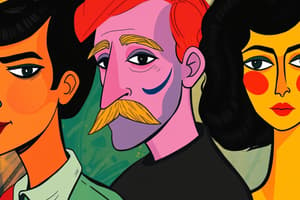Podcast
Questions and Answers
What is the definition of a dynamic character?
What is the definition of a dynamic character?
- A character who influences the main character's decisions.
- A character that remains the same throughout the story.
- A character that acts solely for comedic effect.
- A character that undergoes change due to the events in the story. (correct)
What is the main role of the antagonist in a story?
What is the main role of the antagonist in a story?
- To support the protagonist's goals.
- To provide comic relief in the narrative.
- To narrate the events taking place.
- To oppose the main character's objectives. (correct)
Which of the following best describes indirect characterization?
Which of the following best describes indirect characterization?
- When the writer explicitly states a character’s traits.
- When a character describes themselves to the reader.
- When the setting influences a character's personality.
- When the reader infers characteristics from the character's actions. (correct)
What type of conflict occurs when a character faces challenges outside of themselves?
What type of conflict occurs when a character faces challenges outside of themselves?
What literary device is used to provide hints about future events in a story?
What literary device is used to provide hints about future events in a story?
Which of the following options best illustrates direct characterization?
Which of the following options best illustrates direct characterization?
What character type shows transformation due to events in the story?
What character type shows transformation due to events in the story?
Which type of conflict occurs when a character faces their own fears?
Which type of conflict occurs when a character faces their own fears?
How does indirect characterization primarily reveal a character's personality?
How does indirect characterization primarily reveal a character's personality?
What literary device involves an interruption to show past events?
What literary device involves an interruption to show past events?
Which term describes a character that remains unchanged throughout the story?
Which term describes a character that remains unchanged throughout the story?
Which of the following best illustrates foreshadowing?
Which of the following best illustrates foreshadowing?
Flashcards are hidden until you start studying
Study Notes
Character Types
- Protagonist: The central character around whom the story revolves, typically facing challenges or conflicts.
- Antagonist: The character that opposes the protagonist, creating tension and conflict within the narrative.
- Static Character: Remains unchanged throughout the story, providing stability or supporting roles.
- Dynamic Character: Experiences significant development or transformation as a result of the plot's events.
Characterization
- Characterization: The method used by authors to convey a character's personality and traits to the reader.
- Direct Characterization: Involves explicit statements made by the author regarding a character's traits, making it clear what the character is like.
- Indirect Characterization: Revealed through various means such as thoughts, feelings, actions, dialogue, and physical descriptions, encouraging readers to infer character traits.
Types of Conflicts
- External Conflict: Involves a struggle between the character and an outside force, such as another character, society, or nature.
- Internal Conflict: Centers on a psychological struggle within the character, reflecting their thoughts, emotions, or moral dilemmas.
Literary Devices
- Flashback: A narrative technique that interrupts the chronological flow to depict past events, providing background and context.
- Irony: The occurrence of a situation that is sharply different from what is expected, creating a twist or unexpected outcome.
- Foreshadowing: The strategic use of hints or clues to suggest future events in the plot, building anticipation and tension.
Character Types
- Protagonist: The central character around whom the story revolves, typically facing challenges or conflicts.
- Antagonist: The character that opposes the protagonist, creating tension and conflict within the narrative.
- Static Character: Remains unchanged throughout the story, providing stability or supporting roles.
- Dynamic Character: Experiences significant development or transformation as a result of the plot's events.
Characterization
- Characterization: The method used by authors to convey a character's personality and traits to the reader.
- Direct Characterization: Involves explicit statements made by the author regarding a character's traits, making it clear what the character is like.
- Indirect Characterization: Revealed through various means such as thoughts, feelings, actions, dialogue, and physical descriptions, encouraging readers to infer character traits.
Types of Conflicts
- External Conflict: Involves a struggle between the character and an outside force, such as another character, society, or nature.
- Internal Conflict: Centers on a psychological struggle within the character, reflecting their thoughts, emotions, or moral dilemmas.
Literary Devices
- Flashback: A narrative technique that interrupts the chronological flow to depict past events, providing background and context.
- Irony: The occurrence of a situation that is sharply different from what is expected, creating a twist or unexpected outcome.
- Foreshadowing: The strategic use of hints or clues to suggest future events in the plot, building anticipation and tension.
Studying That Suits You
Use AI to generate personalized quizzes and flashcards to suit your learning preferences.




